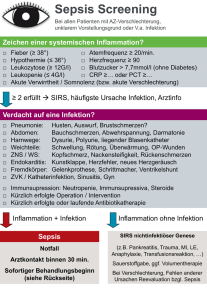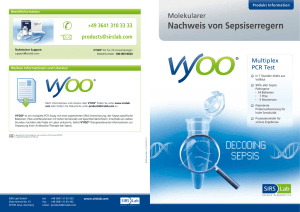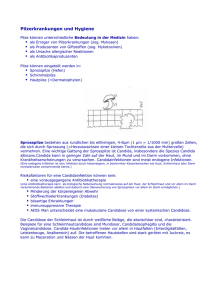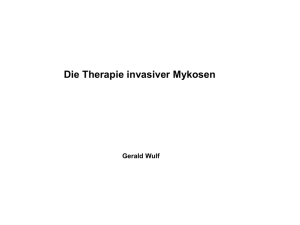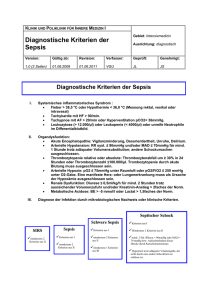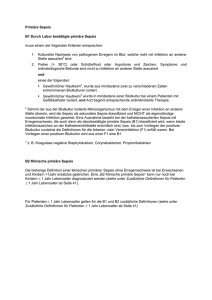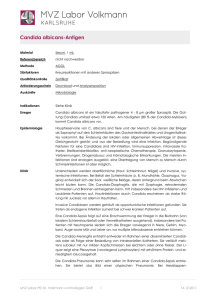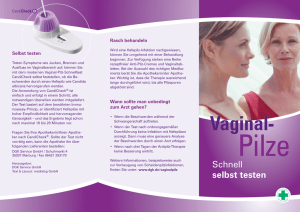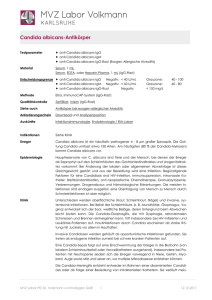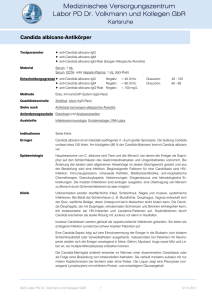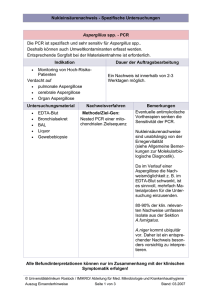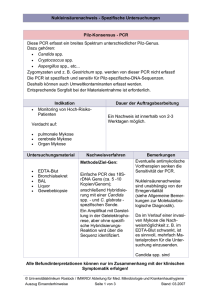Weigand_Diagnostik Pilzinfektionen
Werbung
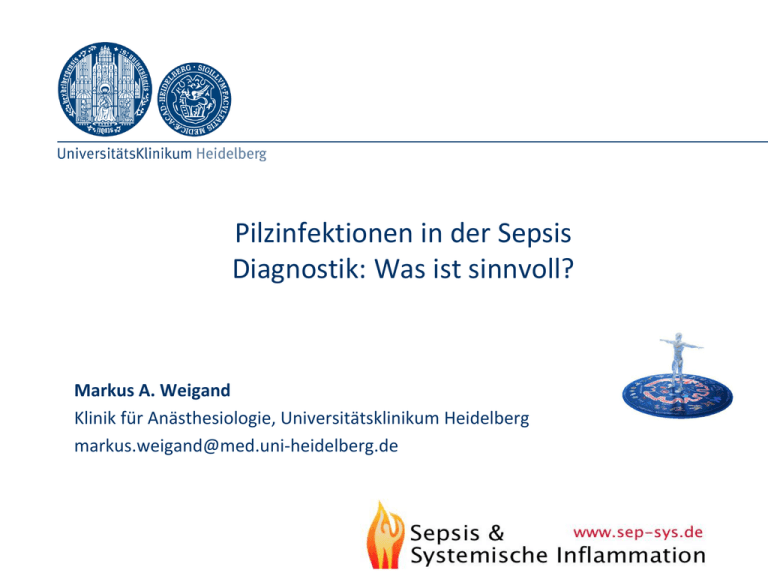
Pilzinfektionen in der Sepsis Diagnostik: Was ist sinnvoll? Markus A. Weigand Klinik für Anästhesiologie, Universitätsklinikum Heidelberg [email protected] Erklärung zu Interessenkonflikten Vortragshonorare Astellas Pharma Astra Zeneca BBraun Biosyn CLS Behring Eli Lilly Gilead Glaxo Smith Kline Janssen Köhler Chemie MSD Sharp & Dohme Novartis Orion Pharma Pfizer Pharma Advisory Boards Astellas Pharma, BBraun Gilead MSD Sharp & Dohme Pall Medical Pfizer Pharma Übersicht • • • • Einführung Risikofaktoren / Scores Problem Diagnostische Möglichkeiten MAXSEP Studie: Meropenem vs. Meropenem plus Moxifloxacin Sepsis in Deutschland: Epidemiologie Erreger Alle Patienten (n=551) Alle Nachweise Blutkultur Gram-positiv 296 (53,72%) 107 (19,42%) Gram-negativ 271 (49,18%) 74 (13,43%) Pilze 159 (28,86%) 13 (2,36) Candida albicans 109 (19,78%) 7 (1,27) Non-albicans 74 (13,43) 7 (1,27) Aspergillus spp. 2 (0,36) 0 Andere Pilze 16 (2,90) 0 F.M. Brunkhorst et al. JAMA 307(22) (2012) 4 Euro Surveill. 2013;18(24):pii=20505 5 Pilznachweis bei abdomineller Sepsis Retrospektive Analyse von Patienten mit abdomineller Sepsis (operative Revision) (n=283) • Positiver Pilznachweis: Insgesamt n=147 (51,9%) • Candida spp. n=145 (51,2%), Aspergillus spp. n=9 (3,1%) • Intraabdomineller Candida-Nachweis n=84 (29,7%) Postoperative Peritonitis Kein Pilznachweis Positiver Pilznachweis (n = 136) (n = 147) 87 (64,0) 111 (75,5) Ursache der Peritonitis: 0,034 0,007 Colon 58 (42,6) 45 (30,6) Gastroduodenal/Billiär 17 (12,5) 31 (21,8) 26,28 ± 8,9 29,89 ± 8,5 APACHE II p <0,001 Lichtenstern Mycoses 2015 Pilznachweis bei abdomineller Sepsis Retrospektive Analyse von Patienten mit abdomineller Sepsis (operative Revision) (n=283) Positiver Pilznachweis: Insgesamt n=147 (51,9%), Candida spp. n=145 (51,2%), Aspergillus spp. n=9 (3,1%) Intraabdomineller Candida-Nachweis n=84 (29,7%) Candida-Kolonisation 95 (64,6) Candida-Infektion 50 (34,0) Candidämie Aspergillus-Nachweis 14 (9,5) 9 (3,1) 1. Nachweisort: Respirationstrakt 98 (66,6) Abdomen 29 (19,7) Wunde 17 (11,56) ZVK 2 (1,3) Blutkultur 1 (0,68) Lichtenstern Mycoses 2015 7 Strategien Prophylaxe Empirische z.B. LeberTX LungenTX Peritonitis Risikofaktoren Antibiotikarefraktäres Fieber möglich Prä-emptive + Antigennachweis Radiologische Hinweise wahrscheinlich Frühe Therapie? Scores + Biomarker + Candida DNA Spezifische + Kultur Gewebe nachgewiesen Prophylaxe: Metaanalyse Antimykotische Prophylaxe (Fluconazol) bei nicht-neutropenen Intensivpatienten • Reduktion der Inzidenz von Candidainfektionen (OR 0,47; CI 0,32-0,71) • Keine signifiante Reduktion der Letalität von Candidainfektionen (OR 0,76; CI 0,56-1,07) Playford EG, et al. J Antimicrob Chemother 2006 57: 628-38 Übersicht • • • • Einführung Risikofaktoren / Scores Problem Diagnostische Möglichkeiten Risikofaktoren für invasive Pilzinfektionen „Intensivmedizin“ ist ein Hauptrisikofaktor für Candida-Infektionen 76% der Candidämien treten in den ersten 3 Wochen nach ICU-Aufnahme auf. Vorerkrankungen/Vormedikation sind Hauptrisikofaktor für AspergillusInfektionen Lichtenstern C et al. Anaesthesist 2010 59:30 Prädiktion der Candida-Infektion auf Intensiv Candida Score • Operation (1) • Multifokale Kolonisation (1) • Parenterale Ernährung (1) • Schwere Sepsis (2) Candida Score Cut off Inzidenz (95%CI) RR (95%CI) <3 3 4 5 2,3 (1,1 – 3,5) 8,5 (4,2 – 12,7) 16,8 (9,7 – 23,9) 23,6 (12,4 – 34,9) 1 3,7 (1,8 – 7,7) 7,3 (3,7 – 14,5) 10,3 (5,0 – 21,0) Positiver prädiktiver Wert Negativer prädiktiver Wert 27,4% (16,8-40,2%) 90,8% (78,3-97,5%) Niedriger Candida-Score schließt Candidiasis aus ! Lam et al. Crit Care Med 2009, 37:1580 Bruyere et al. BMC Infect Dis 2014 14:385 12 Ostrosky‐Zeichner, CID February 18, 2014 • Intensivpatienten (Aufenthalt min. für 2 Tage, erwartet min. 2 weitere Tage) • Clinical Prediction Rule: • • (Z.n.) Beatmung + ZVK + Breitspektrumantibiotika und min. 1 folgendes Merkmal: • Parenterale Ernährung • Hämodialyse • Operation (letzte 7 Tage) • Pankreatitis • Immunosuppressivatherapie (> 1 Gabe) letzte 7 Tage) • Ausgeschlossen: • Überempfindlichkeit gegen Echinocandine • Neutropenie (<500/mm3) • AIDS • Aplastische Anämie • chronische Granulomatose • moderate/schwere Leberinsuffizienz • Schwangerschaft/Stillen • moribunde Patienten • Antimykotikatherapie in den letzten 10 Tagen Ostrosky‐Zeichner, CID February 18, 2014 Es existiert keine klinische Studie, die den Erfolg einer strukturierten klinischen Risikostratefizierung (z.B. Candida Score) für eine empirische antimykotischen Therapie zeigen konnte, da die Inzidenz der Candidämie in den definierten Risikopopulationen zu gering war! Übersicht • • • • Einführung Risikofaktoren / Scores Problem Diagnostische Möglichkeiten Antimykotika innerhalb 24h adäquate Fokussanierung An Fokusanierung denken! • Katheter entfernen • Operative Fokussanierung 21 CRITICAL WINDOW: 12–24 H C. albicans: 25 % > 3 Tage C. glabrata: 25 % > 4 Tage JOURNAL OF CLINICAL MICROBIOLOGY, Sept. 2011, 49(9),3300–3308 22 Übersicht • • • • Einführung Risikofaktoren / Scores Problem Diagnostische Möglichkeiten Pathogenese Pilzinfektionen Unspezifische klinische Symptomatik Schwere Infektion, Sepsis, Organversagen nicht kolonisiert gering kolonisiert stark kolonisiert Candida Infektion Candidämie Kolonisation -- -- +/- ++ +++ Biomarker, Candida-DNA Modifiziert nach Leon et al. Int Care Med DOI 10.1007/s00134-014-3281-0 24 Dilemma der späten Diagnose • Unspezifische Klinik der Pilzinfektion • Nachweismethoden: • Nur 50-60% der Blutkulturen bei Candidämie werden positiv • Positiver Pilznachweis zumeist erst Tage nach Probennahme Lichtenstern C et al. Anaesthesist 2010 59:30 Alexander B, Pfaller MA CID 2006 43:S15 Diagnostik der Infektion: Blutkulturen 1. Revision der S-2k-Leitlinie 2010 der DSG und der DIVI: Prävention, Diagnose, Therapie und Nachsorge der Sepsis Sichere Diagnose Aspergillose: eine Studieneinteilung Sterblichkeit Bewiesen • Histopathologisch nachgewiesene Gewebeinvasion durch Aspergillus Hyphen Mutmaßlich • Aspergillus positive Kultur der oberen Atemwege • Klinische Symptome • Radiologische Zeichen einer pulmonalen Infektion • Host factors/semi-quantitative Asp pos BAL Kolonisation • Aspergillus positive Kultur • >= 1 Kriterium der putativen IA fehlend 79% 67% 38% Intensive Care Med (2014) 40:723–726 Encouraging results were observed for the diagnosis of IA, since the BG test was found to be more sensitive than the GM test for patients with proven or probable IA, but this higher sensitivity was associated with lower specificity versus the GM test. Aspergillus: Galactomannan aus BAL Hage Curr Opin Pul Med 2011,17 30 30 Galactomannan (GM) antigen detection in serum is an effective tool for diagnosing IPA in neutropenic patients. Unfortunately, exposure to moldactive antifungals reduces its sensitivity and diverse factors lead to falsepositive results [1, 10]. GM is cleared by neutrophils and data on serum GM detection in non-neutropenic patients suggest that it has limited value for IA diagnosis in such patients. However, GM detection in bronchoalveolar lavage fluid (BAL) may be a useful tool for IPA diagnosis in the non-neutropenic population. Polymerase chain reaction (PCR) for IPA diagnosis seems to be more sensitive than GM assay, but its use is limited because of lack of standardization of the method and, moreover, it has not been specifically tested in ICU patients [1]. spezifische Zeichen im ThoraxCT Nicht-neutropene Patienten zeigen sehr selten Unspezifische radiol. Zeichen spezifische radiologische Zeichen (Halo, Luftsichel-Zeichen) Die invasive Aspergillose geht immer mit einer Gefäßinvasion einher Nachweis von lokalen Embolisationen im Angio-CT The immunochromatographic LFD incorporates a monoclonal antibody (MAb), JF5, that binds to an abundant extracellular glycoprotein antigen secreted during active growth of Aspergillus spp. The MAb is highly specific for Aspergillus species and does not cross-react with other clinically relevant fungi. In combination with PCR, it provided both 100% sensitivity and 100% specificity. Candida 35 New SCC recommendations We suggest the use of the 1,3 beta-D-glucan assay (2B), mannan and anti-mannan antibody assays for the early diagnosis of invasive candidiasis. (Grade 2C) 37 38 39 Candisep-Studie – Sepnet ß-Glucan basierte Therapieindikation Frank Bloos Eur J Clin Microbiol Infect Dis Received: 26 May 2014 /Accepted: 27 August 2014 ROC curve and AUC when comparing (1,3)-beta-D-glucan (BG) levels in a control group to patients receiving more than 30 g of albumin 2 days before the BG assay. BG cut-off value: 203.7 pg/mL 1,3-β-D-Glucan • (1,3)-β-D-Glucan ist ein Hauptbestandteil der pilzlichen Zellwand verschiedener Pilze (u.a. Pneumocystis, Aspergillus, Candida) • Für Candida: Sensitivität ca. 80%; Spezifität für Infektion sehr variabel 50-80%; unklarer Cut-off; ein Vorschlag: BDG negativ <60pg/ml, intermediär 60-120pg/ml, positiv >120pg/ml Intraabd. Candidiasis vs. Kolonisation: 253 pg/ml vs. 99 pg/ml • Unzureichende Datenlage als Mittel der Therapiesteuerung Guter negativer Prädiktiver Wert: bei negativem 1,3-β-D-Glucan ist ein Absetzen einer empirischen Therapie wohl möglich Falsch positive Werte: z.B. bei >30g Albumin Substitution (Filtergaze bei Herstellung), verschiedene Penicillin-AB Mycoses, 2014, 57, 679–686 Eur J Clin Microbiol Infect Dis 2014 Am J Respir Crit Care Med 2013, 188(9):1100 Infektionsdiagnostik: Kultur-abh. vs. Kultur-unab. Nachteile Kultur-basierter Diagnostik: • zeitaufwendig (2-5 Tage) • eingeschränkte Sensitivität häufig falsch negativ, v.a. unter AB-Therapie • eingeschränkte Diskrimination Infektion vs. Kolonisation vs. Kontamination? Alternative 1: PCR-basierte Diagnostik (z.B. IRIDICA, SeptiFast, etc.) PCR-basierte Diagnostik: • schnell, da nicht Kultur-basiert • Primerauswahl determiniert zu detektierende Erreger (= Targeted Approach) • eingeschränkte Diskrimination Infektion vs. Kolonisation vs. Kontamination? (=nicht quantitativ) • Eingeschränkte Aussage über Resistogramm! 1. Revision der S-2k-Leitlinie 2010 der DSG und der DIVI: Prävention, Diagnose, Therapie und Nachsorge der Sepsis PCR reduces time to therapy • 32 candidaemias and 32 matched pts with sepsis (11: + panfungal PCR) • Antifungal therapy initiation: 67.5 h (candidaemia) vs 31 h (PCR) VYOO®, SIRS-Lab, Jena, Germany Bloos F. J Crit Care 2013;28:2–8 Infektionsdiagnostik: PCR/ESI-MS Results from the RADICAL study Methodik: • multizentrisch (9 ICUs), europäisch • 10/2013-06/2014 • n=529 mit insg. 616 BSI-Proben • Ziel: Vgl. PCR/ESI-MS vs. Kulturbasierte Erregerdiagnostik Vincent JL et al., Crit Care Med 2015; 43: 2283-91 Kultur-unabhängige Verfahren? Alternative 2: (Next Generation Sequencing / NGS) Plasma cfDNA-Isolation NGS-basierte Diagnostik: • schnell, da nicht Kultur-basiert • sehr sensitiv, selten falsch negativ • sehr spezifisch, selten falsch positiv • detektiert alle Pathogene (= offener Approach) • gute Diskrimination Infektion vs. Kolonisation vs. Kontamination! (=quantitativ) • Vorhersage Resistenzphänotypen! Sequenzierung Pathogen-Reads: Klassifikation Quantifizierung Resistenzgene Grumaz S et al., Lancet Infect Dis 2015 – Submitted. Klinisches Vorgehen: Candidiasis Neutropene Patienten Indikationen für eine antimykotische Therapie Risiko Immunsupprimierte Patienten (SOT, entzündliche Erkrankungen) • Immer bei Kultivierung aus primär sterilen Stellen (Blut, Liquor, Gewebe) Funktionell Immunsupprimierte (erniedrigtes HLA-DR) • Kultivierung von Candida aus dem Abdomen und rekurrente gastrointestinale Perforationen / Leckage oder keine Besserung auf Antibiotika bei saniertem Fokus • Bei medikamentös immunsupprimierten oder neutropenen Patienten bei vorhandener Infektion und Pilznachweis z. B. aus Abdomen oder BAL • Bei medikamentös immunsupprimierten oder neutropenen Patienten in der empirischen Therapie der schweren Sepsis • Bei nicht-immunsupprimierten Patienten und Kultivierung von Candida aus der BAL (≥105 CFU/ml) (nicht Trachealsekret!), persistierender Sepsis und keine Besserung auf Antibiotika • Prophylaxe nach Leber-TX, Lungen-TX Aus Pilzinfektionen in der Intensivmedizin, Weigand/Hoppe-Tichy (Hrsg), Unimed Verlag 2011 Universitätsklinik für Anästhesiologie Heidelberg Danke für Ihre Aufmerksamkeit! [email protected]
